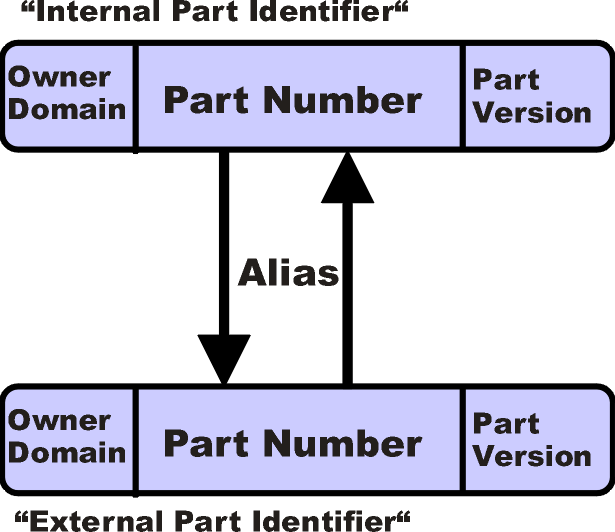Part Number, Part Identifier and Part Version
Products are made up of Parts. They consist of Parts. Parts may compose an Assembly, a Module or a Component or even a Product. Assemblies, Modules and Components are clusters or sets of Parts that in their turn make up the Product.
Parts were normally and still often are identified by Part Numbers. A Part Number should normally be a non-significant number possibly prefixed with a code that identifies the Origin of the Part (where does it come from: ”place of birth” and/or ”owner”. By non-significant I presume a number assigned as a consecutive running number with no properties built in.
Part Numbers may be used for Parts of course, but may also be used as identity for Documents related to Parts (drawings, specifications, test reports etc.).
However, in a big enterprise that is made up of several acquired companies the same Part Number may have been used for different Parts as assigned by different companies within the enterprise, i.e. colliding Part Numbers. This calls for a technique where you will have to be able to differentiate between two or more physical Parts with the same Part Number where these are related to different ”Origins” (companies within the enterprise). A Part Identifier will be a good solution.
A Part or Item Identifier consists of
 an Owner Domain which identifies the ”owner” of the Part Number Series within the Group. This company is the only one that has the right to make engineering changes to the Part
an Owner Domain which identifies the ”owner” of the Part Number Series within the Group. This company is the only one that has the right to make engineering changes to the Part - and a Part Number, normally serially assigned out of an assigned Part number Block and
- and finally the Part Version.
The format for each of these three components will have to be decided within the enterprise.
It is essential that there is a person appointed with the responsibility for the Part Identifiers and the corporate Part Number Series and the usage of these, since the Part Identity is the single most important Identity of any Company making Mechatronic Products.
Basic rules:
- Within an Enterprise there should never be duplicate Part Identifiers for the same physical Part and there should never be two parts with identical Part Identifiers.
- Within an Enterprise you are liable to find duplicate Part Numbers for the same physical Part and it will happen that you find two or more parts with the same Part Number.
 The different companies within an Enterprise will of course have assigned different Part Numbers to basically the same Part: typically Standards Hardware and Parts used commonly all over the industry, i.e. Parts with duplicate Part Numbers. The solution here is the use of aliases between the Part Identity.
The different companies within an Enterprise will of course have assigned different Part Numbers to basically the same Part: typically Standards Hardware and Parts used commonly all over the industry, i.e. Parts with duplicate Part Numbers. The solution here is the use of aliases between the Part Identity.
By Alias it is assumed that one physical Part will have two or more different Part Numbers within the Enterprise. This will have to be overcome by a Part Number Cross Index Database. In this database it shall be possible to cross-reference Part Numbers as they are used by the different companies within the Enterprise and even Part Numbers used by Vendors and Partners. This database will be of great importance to Product Engineering and Customer Support (for Spare Parts).
Since a Part will have a Life Cycle as a Nominal Part with a number of Engineering Changes, a Generic Part Number will not be enough to identify a specific Part. It is necessary to have a Part Version to identify a physical Part and the proxies used to represent the Part in the databases. A Part Number is just a generic identity for a number of versions of the Part. When holding a physical Part in your hand, it will always be a specific Part Version of that Part.
Within a company there will have to be rules which define when a Part should get a new Part Version and when it is necessary to assign a completely new Part Number.
A generally accepted rule says:
When a Part is changed in way so that it is still interchangeable with the previous Part Version regarding ”Form, Fit and Function” (FFF) it will just get the next higher Part Version. If it does not fulfill this requirement, it will be necessary to assign a new Part Number and a new Part Identifier.
It is a human decision to determine when the FFF is maintained and when it is not! This should never be left to mechanized rules!
Most companies I know, do not use the version to lable the bins where parts are stored. This implies that any parts found in a bin can be used in products where the Part Number is specified! Part Versions have to be interchangeable!
Hence, Part Version is something that is used to relate Part Document Versions to Part Versions in order to be able to track change history in documents.
